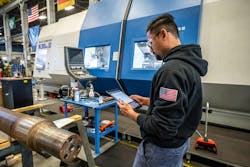Author: John Davagian, CEO at L2L
It’s an obvious yet often overlooked fact that operators, technicians, and supervisors make up the backbone of the manufacturing industry.
These frontline professionals are the key to creating the nimble, flexible operations that can weather economic challenges like supply chain disruptions, uncertainty with tariffs and global trade policy, and capacity constraints.
However, manufacturers are also grappling with a growing skills gap on the production floor. According to new research from L2L, 67% of manufacturing professionals say they’ve witnessed major skills deficiencies in their organizations.
This skills gap is causing serious production issues, such as delayed shipments, human error, safety hazards, and quality defects, increasing waste while hurting productivity.
But to stay efficient and profitable in uncertain market conditions, industrial companies have no choice but to close this gap—fast.
What’s causing the manufacturing skills gap?
The skills gap impacts every area of manufacturing operations, compounding the effects of the aforementioned industry challenges. With most surveyed manufacturing professionals reporting skills deficiencies causing problems in their plants, the industry has substantial room to grow in terms of workforce efficiency and productivity.
So, how did we get here?
Today’s industrial sector is scrambling to replace an aging workforce. Skilled manufacturing veterans are leaving at alarming rates—and taking their knowledge with them. Unfortunately, companies have done a poor job of documenting and sharing this knowledge among newer employees, creating rigid operations that struggle to adapt when key personnel leave.
We must also realize that the skills required for most frontline manufacturing jobs aren’t typically taught in high school or college. Trade schools offer a great foundation for manufacturing careers, but many would rather save the required time and money. And even vocational training can’t completely prepare a future mechanic or welder for the nuances of roles across companies and industries.
Given that most new frontline hires start out of high school, this leaves us with on-the-job training. But how effective is it, really? And how well does it prepare workers to pivot when market conditions change?
What we learned from over 600 frontline professionals
The state of training and professional development in manufacturing leaves much to be desired. According to L2L’s latest report, only 25% of survey respondents considered their organizations’ training program “very effective.”
As a result of lackluster training programs and resulting skills deficiencies, respondents cite the following problems on the shop floor:
● 66% report production delays
● 44% report increased downtime
● 35% report reduced profitability
Not only is the industry suffering from a lack of skilled hires, but training programs as they currently exist aren’t doing much to solve the issue or build the agility needed to respond quickly to market shifts.
The steep cost of inaction
Simply put, manufacturers aren’t doing enough to prepare and retain the employees they do have, leaving them vulnerable when economic conditions demand rapid adaptation.
During the first few months of employment, a crucial period for new hires, most organizations fall short. A staggering 57% of respondents say the training they receive isn’t specific enough to their roles. Nearly half point to outdated materials, and 45% say training isn’t engaging or interactive, leading to poor information retention.
This lack of early investment in frontline professionals leads directly to high turnover, something more than half of respondents report experiencing in the last year alone. And the ripple effects are severe:
● 64% say turnover leads to increased workloads
● 58% report reduced morale
● 49% experience production delays
The exodus of skilled labor is already eroding performance. If the trend continues, companies risk further compromising productivity, quality, and safety—and, ultimately, their ability to withstand economic challenges and pivot quickly when disruptions emerge.
Upskilling: The overlooked ROI driver in manufacturing
The solution isn’t just hiring more people, but growing the potential of the workforce that’s already there. That means upskilling and cross-training aren’t just beneficial, but mission-critical.
Yet, only 48% of respondents say their companies offer any form of upskilling beyond initial training. That creates a huge missed opportunity, especially when the benefits of these programs are clearly documented:
● 99% of those with access to ongoing training say it’s vital to career advancement
● 97% say it increases their workplace confidence
● 95% say it boosts job satisfaction
Upskilling also drives better outcomes for the business. In fact, 97% of those surveyed say continuous development is essential for long-term industry resilience. Cross-trained employees can shift between functions as needed, which enables manufacturers to reallocate resources quickly when market conditions change.
The numbers speak for themselves. Companies that fail to build career pathways for frontline professionals will lose them to competitors, other industries, or burnout.
Digital transformation: A wake-up call, not a magic bullet
The future of manufacturing is digital, but it still relies on people. And frontlines aren’t resistant to change. In fact, 82% say they feel at least somewhat prepared for AI, automation, and other advanced technologies.
Even more encouraging, 77% believe AI will revolutionize manufacturing in the next five years, while 75% say AI can simplify and accelerate processes, providing the agility manufacturers need.
However, enthusiasm doesn’t equal readiness. While many professionals are optimistic, adoption remains slow:
● Only 47% of manufacturers currently use real-time analytics to visualize performance
● 38% use predictive maintenance tools to prevent breakdowns
● Just 22% are tapping into AI-driven decision-making tools to optimize operations
The gap between belief and execution highlights a common problem in manufacturing: knowing what needs to be done, but lacking the infrastructure—or will—to follow through. However, companies that connect their teams with advanced tools that improve visibility, accelerate productivity, and refine processes will be best positioned to navigate economic turbulence.
Closing the gap to safeguard the future
While manufacturers can’t control policy changes or supply chain disruptions, they can control how prepared their workforce is to adapt. The data is clear: staying resilient amid economic volatility requires an efficient, agile workforce—perhaps the best defense against cost increases.
Manufacturers that optimize frontline training, upskilling, and digital readiness will build resilient operations, retain top talent, and respond faster to whatever comes next. Before cutting headcount to offset cost increases, leaders should ask themselves: Are we solving the right problem?
The smartest investment in today’s volatile market isn’t necessarily in protectionist strategies. It’s in technologies that bring systems and people together to perform at their best and profitably meet demand—no matter what economic challenges arise.
Learn how industrial leaders are taking action in the upcoming webinar, Workforce Crisis: How Manufacturers Can Close the Skills Gap.
Additional Resources
Download the 2025 Manufacturing Skills Report to see what’s really driving the frontline skills crisis and how top manufacturers are solving it.
In this video, experts react to new data on the manufacturing skills gap—and just how serious it is. Learn which skills are missing, what companies are doing to close the gap, and how advanced technologies like AI and automation affect frontline work.
This article was written with the assistance of Evelyn DuJack, Content Marketing Manager at L2L.
Photo by Cappella Photography (captured at NSH USA Corporation)
Sponsored by:

